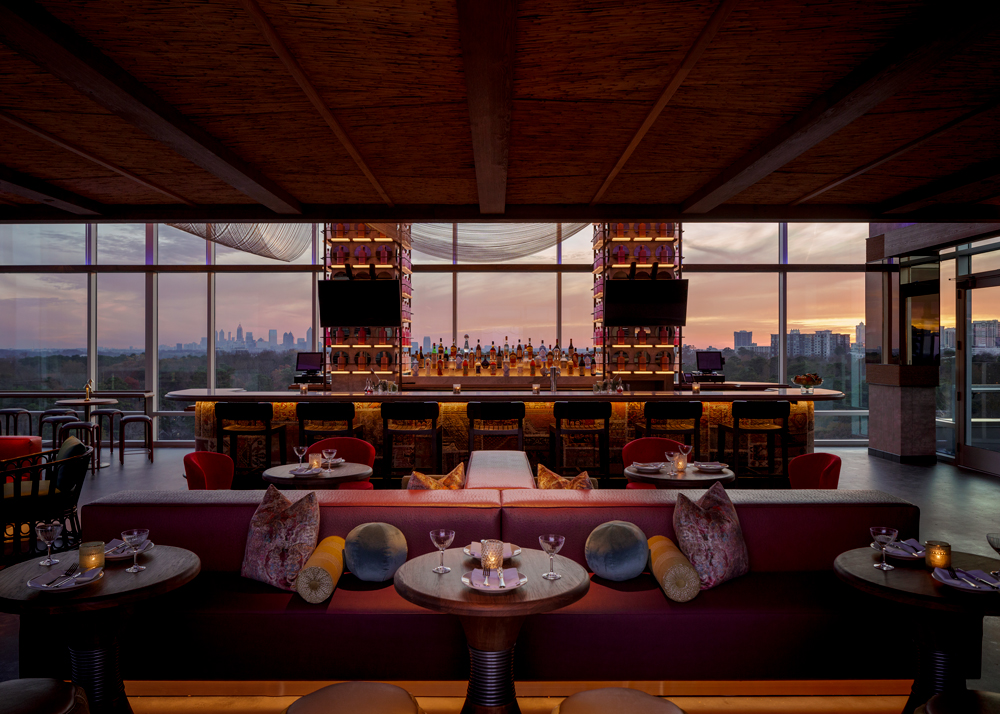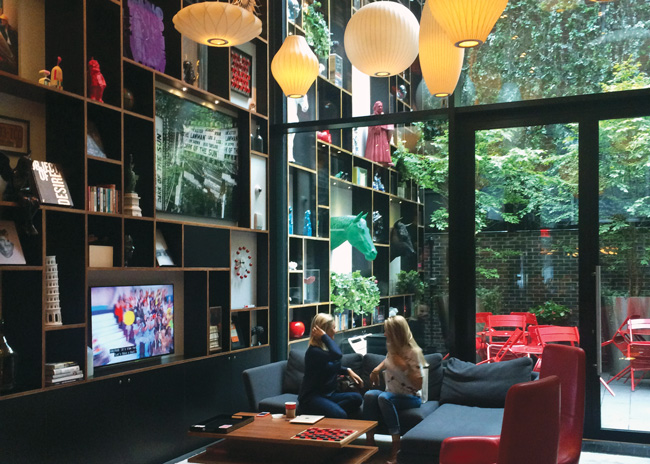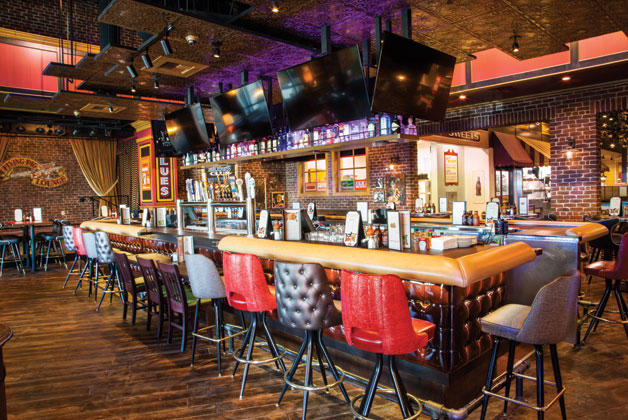 Images courtesy of Ziv Sade PhotographyWhen Prince Riley and his wife Athena Riley began taking steps in 2021 to open their own restaurant, it wasn’t going to be in Los Angeles and it wouldn’t be named Joyce. It would be Olivia, named for their daughter, and it would be in suburban Orange County, Calif., where Prince had managed and helped grow a full-service chain concept for nearly a decade. But as anyone in restaurant development knows, things sometimes don’t go according to plan.
Images courtesy of Ziv Sade PhotographyWhen Prince Riley and his wife Athena Riley began taking steps in 2021 to open their own restaurant, it wasn’t going to be in Los Angeles and it wouldn’t be named Joyce. It would be Olivia, named for their daughter, and it would be in suburban Orange County, Calif., where Prince had managed and helped grow a full-service chain concept for nearly a decade. But as anyone in restaurant development knows, things sometimes don’t go according to plan.
The first snag? Orange County, which fared better than many areas during the pandemic, proved a difficult market in which to find an affordable site. After a nearly two-year search, the couple’s realtor convinced them to look north toward Los Angeles, where a high-visibility, high-traffic restaurant space in the financial district was available. The previous operator had invested heavily in the space to open right before the pandemic hit, Athena notes, but was forced to shutter within months.
The second snag: While the site was perfect for the Rileys on many levels, shortly before lease-signing they learned that a new restaurant had just opened not far from their chosen location. Its name? Olivia.
 To create comfort and connectedness with art deco architecture in the neighborhood, the designer incorporated residential touches, deco shapes and vintage elements.“We fell in love with the space right away,” Athena Riley says. “The architecture is great. It has high ceilings, a large bar, the kitchen is huge — roughly half the size of the restaurant — and was in immaculate condition. Even the style of what they’d done looked similar to what we envisioned doing. But with another Olivia so close by, we worried the name would cause confusion. That’s when we came up with Joyce. It honors both our daughter and Prince’s mom because they share the middle name Joyce. And Joyce means to rejoice, to bring joy, which fits our mission to bring joy through food and hospitality. It’s one of many pivots we made that ended up making the whole concept stronger.”
To create comfort and connectedness with art deco architecture in the neighborhood, the designer incorporated residential touches, deco shapes and vintage elements.“We fell in love with the space right away,” Athena Riley says. “The architecture is great. It has high ceilings, a large bar, the kitchen is huge — roughly half the size of the restaurant — and was in immaculate condition. Even the style of what they’d done looked similar to what we envisioned doing. But with another Olivia so close by, we worried the name would cause confusion. That’s when we came up with Joyce. It honors both our daughter and Prince’s mom because they share the middle name Joyce. And Joyce means to rejoice, to bring joy, which fits our mission to bring joy through food and hospitality. It’s one of many pivots we made that ended up making the whole concept stronger.”
Finding the right designer to bring their vision for Joyce to life required another shift. One studio hired during concept development and site selection in Orange County turned out not to be a good fit, so when the project shifted to L.A., they parted ways. The architect on the project suggested they talk with L.A.-based Lauren Waters, a residential designer who was seeking to expand into restaurant design. The timeline was short and the budget tight, but the match was a good one.
“Lauren has so much passion and drive, and we really hit it off,” Athena says. “But we also liked that she came with a strong residential design background. We wanted our space to feel homey, inviting and familiar, not commercial, and felt strongly that she would be able to bring that essence to the restaurant. She absolutely executed on it.”
Quick Conversion, Tight Budget
Conversion of the 3,360-square-foot space into Joyce, whose menu showcases modern takes on Southern-style seafood, was necessarily quick — roughly four months between lease signing and opening in August 2023. And money was tight, with the couple themselves, family and friends providing most of the financing. But given the pristine condition of the space, the majority of changes needed were cosmetic in nature.
The existing concrete flooring was retained as was the bar and back-bar structures, the kitchen and arched wall features. Everything else not usable or appropriate to the Joyce concept was sold — garage-sale style — to help fund the project. “We literally put an A-frame sign on the sidewalk in front of the restaurant and people stopped in to look around and buy things,” Athena says. “We sold the dishes, glasses, furnishings. One guy even bought the bar face and, after a bit of bartering, agreed to demo it for free. The biggest shock was the day we sold the 14-foot red velvet banquette. The money we raised from the garage sale really saved us, but it was also a great way to meet and make connections with people in the neighborhood before we opened.”
With the space stripped down, Waters began an aesthetic overhaul, seeking to create a timeless, warm and inviting space that subtly conveys Joyce’s southern soul. Prince Riley’s family hails from the South and happy memories of food and family there inspired the concept, and Joyce’s chef Sammy Monsour describes his cooking style as “Americana, with heavy vibes of Southern technique and sustainable sourcing.”
 Affordable red marble tile was sourced locally for the bar face, lending interest and warmth to the space while keeping the budget in check.
Affordable red marble tile was sourced locally for the bar face, lending interest and warmth to the space while keeping the budget in check.
“Whatever wasn’t structural was changed,” Waters says, of the project’s scope. “We started by peeling everything away and choosing simple, classic elements and finishes that would keep the focus on the food versus on loud design elements or cliched ‘Instagram moments.’ We also looked to the surrounding architecture. There are a lot of beautiful art deco buildings on the street. We wanted Joyce to feel like it has a specific connection to the neighborhood by incorporating a subtle deco style in the design.”
Creating a new seating plan was also a priority. While the previous restaurant’s wide-open dining room had banquettes along the walls and loose tables and chairs in the center, the Rileys wanted a more varied plan. Their goal: to incorporate different seating styles that offer multiple guest experiences and create zones of comfort throughout the space. Generously sized custom curved booths with leather seats and textured fabric backs were added along the front window wall and a double-sided banquette now spans the center of the dining room. That banquette, designed with a residential-style, fabric-covered sofa look and feel, complements a brown leather banquette lining the room’s side wall. Together, they provide plenty of flexibility to combine tables for various party sizes. Two smaller, more intimate booths with red granite-topped tables were added beneath an arched section of the room’s back wall, while two loveseats surrounding a travertine coffee table between the bar and dining room offer a comfortable spot for lounging over cocktails or waiting for a table.
“The tight timeline and budget restricted us in good ways in some senses,” Waters notes. “We had to be decisive and couldn’t get emotionally attached. For the bar, for instance, I initially envisioned cladding it in brass sheet metal to create this big, antique-looking brass bar. But that would have taken up about half of our entire budget. Instead, we found a red mosaic marble tile, which was in stock from a local source, for something like $6 a square foot. We applied that to the face of the bar and it gave it a custom, warm and interesting feel. We wanted to do Venetian plaster on the dining room walls, but that was above budget so we pivoted to a warm, Venetian blue-green paint that ended up being the core brand color. We shopped locally for vintage pieces and had furniture fabricated locally. That was a great process, in part because we could check the work and request adjustments to finishes or comfort levels along the way, but also because it’s a much lower carbon footprint when you’re not shipping new things in from all over.”
While a more varied seating plan helped to accomplish the couple’s goal of creating a neighborhood spot with broad customer-occasion appeal, Joyce is also strategically designed to work well from day into night. Comfortable, bright and airy during lunch and brunch, thanks in part to abundant natural light, Joyce at night projects a more moody, ambient character. Lighting and materiality combine to support that intended all-day appeal.
“We used a lot of fabric, leather and warm woods for comfort, as well as for acoustic dampening, but also lots of ambient lighting and varied lighting styles,” Waters says. “There are table lamps and vintage sconces throughout. Vintage Murano glass pendants hang over the bar and deco-style brass pendants over the window booths. In the center of the restaurant over the banquette is a cluster of large, organic-shaped rattan pendants. At night, it all combines to create a lively, warm and inviting ambiance both inside and from outside looking in.”
 Honoring the heart and soul of Joyce — family — the team commissioned a trio of portraits of Prince’s mom, Brenda Joyce, which hang on the dining room’s side wall.
Honoring the heart and soul of Joyce — family — the team commissioned a trio of portraits of Prince’s mom, Brenda Joyce, which hang on the dining room’s side wall.
Subtle Southern Comfort
Rattan is one of a small handful of materials Waters and Athena Riley selected to support Joyce’s southern accent. In addition to the featured pendants, it’s used as a divider atop the center banquette, in refurbished vintage cane dining chairs, and a vintage rattan bookcase provides extra storage and space for decorative items near the bar.
 Joyce’s seating plan includes custom curved booths with textured fabric backs along the window and a double-sided banquette in the center of the dining room that provides flexibility to accommodate various party sizes. “We definitely wanted an aspect of southern comfort, but at the same time we didn’t want it to be overt or tropical,” Waters says. “We chose a few elements, such as rattan, a velvet palm-print upholstery fabric for some dining chairs, and vinyl seagrass wallcovering behind the bar. They blend pretty seamlessly with the more contemporary elements and art deco silhouettes in the space, lending personality and hints of southern warmth without making it feeling like you’re at a Palm Beach resort.”
Joyce’s seating plan includes custom curved booths with textured fabric backs along the window and a double-sided banquette in the center of the dining room that provides flexibility to accommodate various party sizes. “We definitely wanted an aspect of southern comfort, but at the same time we didn’t want it to be overt or tropical,” Waters says. “We chose a few elements, such as rattan, a velvet palm-print upholstery fabric for some dining chairs, and vinyl seagrass wallcovering behind the bar. They blend pretty seamlessly with the more contemporary elements and art deco silhouettes in the space, lending personality and hints of southern warmth without making it feeling like you’re at a Palm Beach resort.”
And as for personality, one big decision made in the final design stages ultimately worked to underscore the heart and soul behind Joyce — family. The team commissioned a trio of custom portraits depicting Prince’s mom, Brenda Joyce, to hang along the dining room’s side wall.
“We got through everything else and suddenly thought, ‘Wow, this wall is so, so big. What do we put on it?’,” Athena says. “Everything else in the space is so intentional and personal that we didn’t want to just hang some random art there. We finally came up with the portrait idea and I reached out to a few artists whose work I liked. I either got no response or they were very expensive. But during our garage sale we’d sold things to a couple who connected us with an art curator who connected us with Shannon Scates. She’s a black female artist, an L.A. native, whose work was perfect for what we had in mind. I sent her portraits of Prince’s mom and she took it from there. It really brought the whole project together as an ode to strong women and to our family’s life.”
Project Team
- Founders and operators: Athena and Prince Riley
- Co-owners: Sammy Monsour, chef; Kassady Wiggins, beverage director
- Design: Lauren Waters, Lauren Waters Design
- Architect: Leon Lopez
- General contractor: David Alarcon, Patron Construction Services Inc.
- Portrait artist: Shannon Scates, Unparalleled Art
- Furniture fabrication: Mainstreet Workshop
Snapshot
- Concept: Modern Southern coastal
- Location: Downtown Los Angeles
- Project type: Redesign
- Size: 3,360 square feet
- Seats: 94 dining, 10 lounge, 12 bar
- Average check: $40-45, lunch and brunch; $65-$75, dinner
- Project duration: 4 months, lease signing to opening
- Design highlights: Large front windows, deco-style arches, custom portrait trio, rattan pendants, vintage sconces, deco brass and Murano glass pendants, refurbished cane and vintage dining chairs, custom curved booths, calming blue-green and seagrass cloth-covered walls, red tile-faced bar, velvet palm-print upholstery, custom double-sided banquette



